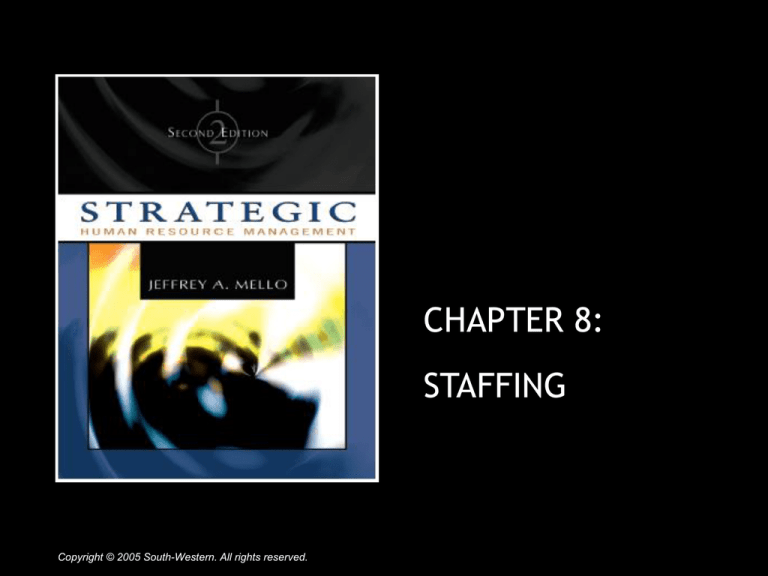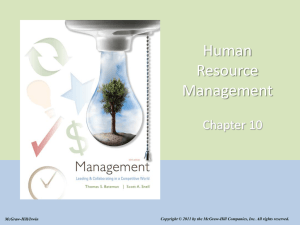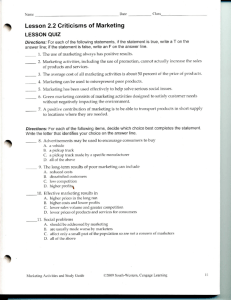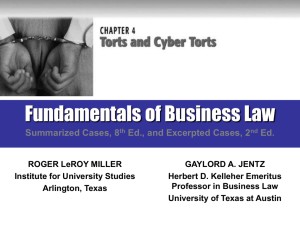
CHAPTER 8:
STAFFING
Copyright © 2005 South-Western. All rights reserved.
Staffing
• Staffing
– Process of recruiting and selecting prospective
employees
– Has significant impact on organization’s bottom line
• Requires staffing process to become strategically
focused
– Recruitment and selection activities offer
organization numerous choices to find and select
new employees
– Staffing decisions need to ensure that employees fit
the organization’s culture
Copyright © 2005 South-Western. All rights reserved.
1–2
Recruiting
• Temporary versus permanent employees
– Increase headcount temporarily or permanently
should be strategically-driven
– Basis for decisions is HR forecast
– Temporary employees less costly
– Temporary headcount increases can be obtained
from specialized agencies
– Headcount increases can be avoided by
subcontracting work
Copyright © 2005 South-Western. All rights reserved.
1–3
Exhibit 8-1
Advantages and Disadvantages of Internal
and External Recruiting
Copyright © 2005 South-Western. All rights reserved.
1–4
Recruiting
• When and how to recruit extensively:
– When do recruiting efforts need to begin?
– How large an applicant pool needed?
– Data from past recruiting efforts utilized
• To answer questions where feasible
• Adjust for changed conditions
• Yield ratios
– Offer information on how many applicants eliminated/remain
at each step in recruitment process
– Can determine proper or necessary size of applicant pool
Copyright © 2005 South-Western. All rights reserved.
1–5
Exhibit 8-2
Recruiting Pyramid
Copyright © 2005 South-Western. All rights reserved.
1–6
Exhibit 8-3
Recruiting Timeline
Copyright © 2005 South-Western. All rights reserved.
1–7
Methods of Recruiting
• Informally or formally
• Internally or externally
• Targeted advertising in selected media
• Recruiting on Internet
• Outsourcing to staffing agencies
• Private Industry Councils (PICs)
• Executive search firms
• On-campus recruiting
Copyright © 2005 South-Western. All rights reserved.
1–8
Recruiting on Internet
• One of the fastest-growing recruitment methods
• More cost-effective than newspaper advertising
• Low cost, speed, and ability to target applicants
with technical skills
• Allows applicants to assess interests and needs
with employer’s offerings
• Global exposure to potential applicants
• Can cut search process time by as much as 75%
– Question: Disadvantages?
Copyright © 2005 South-Western. All rights reserved.
1–9
Recruiting on the Internet
• Some potential challenges
– Ensuring security
– Viruses
– Access to unauthorized areas
– Concerns about disparate impact against
certain protected classes
– Can complicate reporting of data related to
compliance with federal and state laws
Copyright © 2005 South-Western. All rights reserved.
1–10
Selection Process Issues
• Reliability
– Consistency of measurement
– Screening criteria should elicit same results in
repeated trials across time and evaluators
– Reliability influenced by criterion deficiency and
contamination errors
– Reliability is prerequisite for validity
Copyright © 2005 South-Western. All rights reserved.
1–11
Selection Process Issues
• Validity
– Degree to which what is assessed is related to actual
performance
– Ability to establish job-related validity is crucial to employers
in defending themselves in discrimination allegations
– Content validity illustrates that measure or criterion is
representative of actual job content or knowledge
– Criterion-related (empirical) validity demonstrated by
relationship between screening criteria and job performance
Copyright © 2005 South-Western. All rights reserved.
1–12
Interviewing Process Issues
• Who should be involved?
– Prospective supervisors, peers, subordinates
• Which interview format?
– Individual or group interviews
– Situational versus behavioral/experienced-based
• Common interviewer errors
– Similarity errors
– Contrast errors
– First impression
– Halo errors
– Personal biases
Copyright © 2005 South-Western. All rights reserved.
1–13
Behavioral Interviewing
• Used with experienced and inexperienced
applicants
• Asks about situations candidate is likely to
face on job
• Candidates can present real-life situations
they were involved in, and how they
handled them
Copyright © 2005 South-Western. All rights reserved.
1–14
Testing
• Work sample tests
– Ask applicant to complete representative sample of
actual work
• Trainability tests
– Measure
• Aptitude in certain areas
• Ability to understand critical job components that
firm will teach new hires
Copyright © 2005 South-Western. All rights reserved.
1–15
Testing
• Realistic job previews
– Make applicants aware of both positive and
negative aspects of job
– Decrease likelihood new employees will become
dissatisfied
– Increase likelihood of candidate’s self-selecting out
of position
• Personality testing
– Used in an effort to anticipate how applicants might
behave, if hired
Copyright © 2005 South-Western. All rights reserved.
1–16
Exhibit 8-4
The Big Five Personality Dimensions
Personality Dimension
Characteristics of Person Scoring
Positively on Dimension
1) Extraversion
Outgoing, talkative, social, assertive
2) Agreeableness
Trusting, good-natured, cooperative,
soft-hearted
3) Conscientiousness
Dependable, responsible,
achievement-oriented, persistent
4) Emotional stability
Relaxed, secure, unworried
5) Openness to experience
Intellectual, imaginative, curious,
broad-minded
Copyright © 2005 South-Western. All rights reserved.
1–17
Other Testing Methods
• Personality testing
– Useful to anticipate how applicants likely to behave
– Few, if any, jobs require specific personality type
– Have been successfully challenged in court
• Physical testing
– Restricted under ADA to testing only for specific
critical job-related physical performance
requirements
Copyright © 2005 South-Western. All rights reserved.
1–18
Other Testing Methods
• Honesty testing
– Polygraph testing has declined since passage of
Employee Polygraph Protection Act in 1988
– Paper-and pencil tests have increased greatly
• Drug testing
– Challenged in courts as an invasion of privacy
• References
– Little information available due to former employer
fears of liability for libel, slander and defamation
Copyright © 2005 South-Western. All rights reserved.
1–19
WI Statutes, Chapter 895.487
Civil liability exemption; employment references
1(c) "Reference" means a statement about an employee's job performance
or qualifications for employment and includes a statement about an
employee's job performance or qualifications for employment provided
pursuant to the settlement of a dispute between the employer and
employee or provided pursuant to an agreement between the
employer and employee relating to the termination of the employee's
employment.
2
An employer who, on the request of an employee or a prospective
employer of the employee, provides a reference to that prospective
employer is presumed to be acting in good faith and, unless lack of
good faith is shown by clear and convincing evidence, is immune from
all civil liability that may result from providing that reference. The
presumption of good faith under this subsection may be rebutted only
upon a showing by clear and convincing evidence that the employer
knowingly provided false information in the reference, that the
employer made the reference maliciously or that the employer made
the reference in violation of s. 111.322.
Source: http://www.legis.state.wi.us/rsb/Statutes.html
Copyright © 2005 South-Western. All rights reserved.
1–20
Selection for International Assignments
• Reasons for failure on international
assignments
– Interpersonal and acculturation abilities
– Often not based on technical skills
• Test employees’ adaptability, openmindedness, ability to tolerate uncertainty,
ambiguity, and independence
• Interview and screen family members who
would accompany employee (carefully!)
Copyright © 2005 South-Western. All rights reserved.
1–21
Exhibit 8-4
Strategic Issues in Staffing
Copyright © 2005 South-Western. All rights reserved.
1–22
Reading 8.1 (Bowen et al.)
Hiring for Organization, Not Job
• New model of selection geared toward hiring
“whole” person who fits into organization’s
culture
• “Strong situation”
– Intensity of situation suppresses variation in behavior
attributable to person
• “Weak situation”
– Allows range of employee responses to work requirements
• In organizations that are “weak situations”
– More important to do good job of hiring right people
Copyright © 2005 South-Western. All rights reserved.
1–23
Reading 8.1
Hiring Process for Person-Organization Fit
• Assess overall work environment
– Job analysis
– Organizational analysis
• Infer type of person required
–
–
–
–
Technical knowledge, skills and abilities
Social skills
Personal needs, values and interests
Personality traits
Copyright © 2005 South-Western. All rights reserved.
1–24
Reading 8.1
Hiring Process for Person-Organization Fit
• Design “rites of passage” for organization entry
that allow both organization and applicant to
assess their fit
–
–
–
–
Tests of cognitive, motor and interpersonal abilities
Interviews by potential coworkers and others
Personality tests
Realistic job previews, including work samples
• Reinforce person-organization fit at work
– Reinforce skills and knowledge through task design and
training
– Reinforce personal orientation through organization design
Copyright © 2005 South-Western. All rights reserved.
1–25
Reading 8.1
Potential Benefits & Problems with Hiring
for Person-Organization Fit
• Potential benefits
– More favorable employee attitudes
– More desirable individual behaviors
– Reinforcement of organizational design
• Potential problems
– Greater investment of resources in hiring process
– Relatively undeveloped & unproven supporting selection
technology
– May be difficult to use full model where payoffs are greatest
– Lack of organizational adaptation
Copyright © 2005 South-Western. All rights reserved.
1–26
Reading 8.2 (Insch & Daniels)
Reasons for Expatriate Early Departure
•
•
•
•
•
•
•
•
•
•
•
Not performing job effectively
Received other, more rewarding offer (other co.)
Expatriate or family not adjusting
Expatriate or family missing home
Received more rewarding offer (current co.)
Unable to adjust to deprived living standards
Concerned with problems of safety & health
Believed children’s education was suffering
Feared assignment would slow career advance
Spouse wanted career
Compensation package inadequate
Copyright © 2005 South-Western. All rights reserved.
48.4%
43.7%
36.6%
31.0%
17.2%
10.3%
10.3%
7.1%
7.1%
6.1%
0.0%
1–27
Reading 8.3 (Wiechmann et al.)
Frequently Mentioned Obstacles to Global
Staffing System
• Legal requirements across
countries/regions
• Education system across
countries/regions
• Economic conditions across
countries/regions
• Ability to acquire & use
technology
• Labor market variations
• Value differences across
cultures
• Availability of off-the-shelf
translated tools
Copyright © 2005 South-Western. All rights reserved.
• Level of HR experience varies
across regions
• Role of HR in hiring varies
across regions
• Familiarity with a tool or
practice varies
• Misperceptions that something
is a cultural difference
• Limited local resources for
implementation
• Beliefs about whether a global
system is US-centric or
imposed
1–28
Reading 8.3
Frequently Mentioned Benefits to Global Staffing
System
• Global database of qualified
talent
• Global succession planning is
enabled
• Quick identification of
candidates to meet needs of
specific location
• Global HR personnel have
access to the latest versions of
products/tools
• Provision of consistent message
about company to candidates
worldwide
• Shared vision of HR globally
• Quality of all hires is ensured
• Global database as internal
benchmark of achievement in
different parts of world
• Better understanding of
country/regional needs by all
HR
Copyright © 2005 South-Western. All rights reserved.
• Comparisons of staffing results
across locations
1–29






